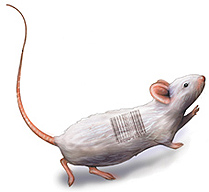






 |
||||
 |
 |
 |
 |
 |
 |
||||

A Tiny History of a Wee Research Tool 1 A.D.: The Chinese regularly domesticate mice as pets. 1852: Gregor Mendel, the Augustinian monk from Moravia who pioneered the study of genetics, begins to investigate mice and their patterns of trait inheritance. Because mice have been selectively bred as pets in China and by the well-to-do in Western Europe, the work of Mendel and succeeding geneticists enjoys a head start. 1907: Clarence Cook "C. C." Little, a Harvard biology student and direct descendant of Paul Revere, looks to turn the mouse into a standardized research tool after rediscovering the once-lost papers of Mendel. He buys mice from collector Abbie Lathrop, a retired schoolteacher who bred mice as pets on her Massachusetts farm. Lathrop mated mice whose forebears had come from Europe and East Asia. 1909: Little develops the first inbred mouse strain, the "dilute brown non-agouti." 1921: Using black mice descended from Lathrop's collection, Little develops the "black 6," which becomes a research staple. Eighty percent of all lab mice today are black 6. 1929: Little, pilloried for espousing strong and controversial views on eugenics, euthanasia, and tobacco use (he argued that there is no link between smoking and cancer), steps down as president of the University of Michigan. With the backing of automotive scion Edsel Ford, he opens the Jackson Laboratory, in Bar Harbor, Maine, today the most notable "mouse factory" in the world. 1941: The Jackson Laboratory publishes Biology of the Laboratory Mouse, the first book devoted to mouse biology and genetics. 1960: Victor A. McKusick, a Johns Hopkins professor and a founding father of the study of genetics, develops the Short Course in Medical and Experimental Mammalian Genetics, still the gold standard for mouse-research education. 1966: Researchers discover gene mutations that make mice autoimmune. 1972: The Jackson Laboratory unveils the first computer database for mouse genetics. 1982: Ralph Brinster, a geneticist at the University of Pennsylvania, and Richard Palmiter, a biochemistry professor at the University of Washington, create the first transgenic mouse. 1987: Mario Capecchi, from the University of Utah, Martin Evans, from Cardiff University, in Wales, and Oliver Smithies, from the University of North Carolina at Chapel Hill, develop a technique to block the expression of a gene, creating a "knockout mouse" that leads to an explosion in genetics-based research. The trio is later awarded the 2007 Nobel Prize in medicine. 1993: The National Institutes of Health creates a program that makes genetically engineered mice widely available to researchers nationwide. 1995: Scientists at Johns Hopkins and Jackson announce creation of a mouse model for Down syndrome. 1998: For the first time, a mouse — named Cumulina — is cloned. 2001: The first draft of a complete sequencing of the mouse genome is published. 2007: A Japanese research team finds that stem cells can be made without embryos — a key that might unlock the possibilities of ethically sensitive stem cell research. The team used the cells of live mice to grow new mouse skin and organ tissue.
2008: The federal government funnels millions of
dollars into a program designed to turn eight mouse types into
1,000 new genetically mixed breeds of research mice, so that
their diversity more closely approximates that of humans. The
program, slated to be completed by 2012, could improve the mouse
as a model for human populations and for the genetic and
environmental complexity of many illnesses. The federal
government also pours millions into another program to completely
map out the functions of each mouse gene. If successful, this
effort will create a strong point of comparison between the
genome of the mouse and of humans, giving scientists a strong
tool with which to find links between specific genes and
disease.
|
 |
|
 The Johns Hopkins Magazine |
901 S. Bond St. | Suite 540 |
Baltimore, MD 21231
The Johns Hopkins Magazine |
901 S. Bond St. | Suite 540 |
Baltimore, MD 21231Phone 443-287-9900 | Fax 443-287-9898 | E-mail jhmagazine@jhu.edu |
|